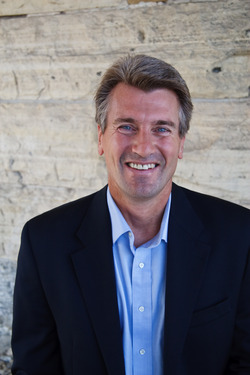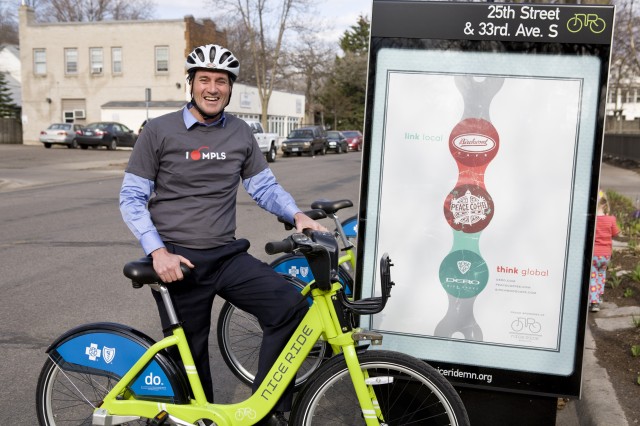DISCOVER YOUR LOCAL BICYCLING COMMUNITY
Find local advocacy groups, bike shops, instructors, clubs, classes and more!
Bikes + Mayors = A Conversation with R.T. Rybak
 R.T. Rybak is proud of his home city. He has reason to be: Minneapolis helped pioneer bikesharing in the United States, it’s got a booming bike community, it’s a Gold-level Bicycle Friendly Community and much more.
R.T. Rybak is proud of his home city. He has reason to be: Minneapolis helped pioneer bikesharing in the United States, it’s got a booming bike community, it’s a Gold-level Bicycle Friendly Community and much more.
Rybak served as Mayor of Minneapolis from 2002 to 2014, helping oversee and push many of the bike efforts in the midwest city. He’s moderating a panel discussion with a handful of mayors from cities across the country at the 2015 National Bike Summit next month. Don’t forget to register today!
We caught up with him to talk more about his time as mayor, what he sees as the challenges facing future elected officials, and how his competitive streak is not just an engine for trash talk, but a powerful tool for elected officials’ to embrace when doing this work.
During your tenure as Mayor, you put a lot of time, effort and funds toward bicycling and walking. Why do it? What’s the value?
I love biking, but it was much more about what kind of city we wanted. I was a kid who had the freedom to hop on my bike and ride on park trails that surrounded beautiful lakes in the city. Every kid in every neighborhood deserves that privilege. Every adult needs to have it, too. I would also say there is a very simple statement that I think explains it all when it comes to why cities should be involved in aggressively positioning themselves to have a strong bike culture:
Freedom to my parents meant having a car.
Freedom to my kids means not being dependent on a car.
And a lot of businesses recognize the workforce does not want ot be required to hop in a car to get to work. American cities for most of my lifetime were built around the idea that the car had to be the dominant feature. The most massive investment in infrastructure in American history was with Interstate Highway System. There was an enormous investment in parking infrastructure. That all meant ripping apart the natural fabric of cities so it could be rerouted to have the car at the center.
Now cities are being rewoven for a biking and walking culture. I love the feel of being on a bike and feeling the open air, but even more importantly, I love the freedom to be able to experience my city at the speed of bike as opposed to the speed of cars.

What challenges did you face? Financial? Community buy-in?
We were on the front end of many bike innovations. That meant we were trying to do things many people hadn’t seen before. It was true of reclaiming car lanes for bike lanes. True of putting precious infrastructure dollars into new bike lanes and sidewalks. It was true when we became the first American city to really successfully do bikeshare. Washington DC had done it. Denver was beginning it. The Nice Ride system that launched here was what I believe broke the dam for bikeshare in the country. It was very new to many people. The most controversial part of it was that I thought the way to start it would be to do a couple kiosks here and then a few more there. But the smart people who advised me on this said I was wrong and can only get right if we build enough stations — it had to be clear that this was a viable transportation network.
When we first figured it would cost $2.5 million to launch it, I literally gasped because I did not understand how I could navigate the politics of that investment. Thankfully I had two huge allies, one being Blue Cross, who gave us $1 million, and also late Congressman Jim Oberstar, who was able to deliver federal money for the area. All that coupled with the amazing group of people growing it has made it incredibly successful. Many people who told me that it would be a flop and wanted nothing to do with it then later would be clamoring for bikes in front of their businesses.
I’m proud of the work we did in the city but we could not have done it without the incredibly powerful bike community, which would constantly back us when we were getting criticism. At one point, a talk radio show took on the bike coordinator being in the budget and drummed up rage about that instead of funding more police officers. I warned council members: Don’t take me on on this — I’m warning you, there is a huge constituency out there. Sure enough, a few council members moved to take the bike coordinator out of the budget and were the swarmed with emails and social media. It showed that you don’t mess with the bike community here. It was really important for those of us who love bikes to realize that you can’t cheer people on from the sidelines. You’ve got to go out and do extremely strong advocacy.
In another example, we had a county-owned road that ran through downtown. The county had the idea to put a bike lane on the street. The bike community said it wasn’t good enough and wanted to use it to pioneer cycle tracks. They did phenomenal organizing and built a constituency and we will get cycle tracks now because they stood up. We should support political leaders who do good things but most importantly tell the phenomenal bike community to look in the mirror and say, ‘Am I doing enough to create citizen infrastructure to make bike infrastructure possible?’
Am I doing enough to create citizen infrastructure to make bike infrastructure possible?
How did the climate change around bicycling in the city over your time as Mayor?
I came into a city that was already very open to bikes. We definitely accelerated that work but we also benefited from real growth of the community. We’ve seen a shocking growth of winter biking. Most people thought that would be unheard of in a place like Minneapolis. But part of it meant that we were also, at the city level, investing consistently in a comprehensive bike strategy even when the budget was really, really tough. The governor at that time, and many members of the state legislature, were very critical of our work — “that flaky mayor with a cute little bike strategy over in Minneapolis” — but we were able to continue because people of the city were very bought into it. They wanted it and stood with me. The county was aggressive, too, and we had Congressman Oberstar. Whenever we opened a new bike path or trail, I’d tell everyone to bow East toward DC as a thanks to him [laughs].
You’ve only been out of office for a year now, but have you noticed / spoken with other mayors who say they are facing different or new challenges?
Then Denver Mayor John Hickenlooper, now Colorado’s Governor, talked about bikeshare a lot and we helped bolster each other. When the Republican and the Democratic National Conventions were in Minneapolis-St. Paul and Denver, respectively, Humana created a temporary bikeshare system. We used that as an opportunity to show people, including Blue Cross, what we were trying to do. We would not have been able to do that had Humana not made that investment. We were both interested in bikeshare at that time. I remember him calling me and saying, ‘Are you really doing this? Because I don’t want to be only one.’ I said, ‘If this fails you won’t’ be the only idiot. It’ll be you and me both pal.’ We were both way out of line — this was frankly kind of flaky stuff for some people. It was working in Paris and it was mediocre at best in Washington at the time.
Now, other mayors face the same set of issues. My advice to them is that the politics may still be a little rocky in some places but you are definitely on the right side of the future. All I have to do is make that simple statement — Freedom to my parents meant having a car,
freedom to my kids means not being dependent on a car — and they get it. They know that those of us who have taken some criticism for this work are definitely on the right side of urban history.
I also hold up innovations in other places. I feel the cultural trail in Indianapolis is really a game changer because it helps show that a comprehensive trail strategy that connects an otherwise disconnected downtown works.
The biggest negative effect of a half century of creating cities for cars meant there was great disconnection in urban cores. One amenity is separated from another by a bunch of parking lots. Indianapolis’s cultural corridor is the best example of bikes as connected tissue. This is the single biggest issue in terms of a physical challenge in American cities today. It’s not just biking, but reshaping a city.
You teach a Mayor 101 class at the University of Minnesota. Is there much discussion of transportation? Bicycling?
Absolutely. I talk a lot about bicycling, but I don’t have a single class on it. It’s woven into much of the work. We spend a lot of time trying to talk about where cities are going and how the bike is part of the culture.
The point I make to my classes is that transportation is a lot like golf. You don’t use your driver on the putting green. Meaning, as much as I love biking, I don’t think of it in isolation — it’s one piece of the new transportation infrastructure a community needs. You need light rail, which is different from street cars, which are different from car share, which are different from bikes, which are different from pedestrians
In Minneapolis, we think of bikes as part of the infrastructure, but so is the skyway system and light rail. It’s all woven together. For example, right about when I was feeling quite good about leading the country with bikeshare I went to Austin, Texas. I was gloating privately that they didn’t have it, but then I saw they had all these Car2Go cars. I said we need those. It’s not about bikes, it’s about seeing that car share extends the range of bikeshare because even if it’s different, it’s all part of living a life not dependent on owning a car.
This is your first National Bike Summit — what are you most looking forward to
I will have mixed feelings at the Summit because I want everyone to know Minneapolis is the No. 1 bike city in America. But I also really want to hear about things we haven’t done yet. I think now the movement has enough of a tipping point that when I come to a conference it won’t be a viewed as a bunch of people planning counter cultural projects. We’re just catching up to where people are already.